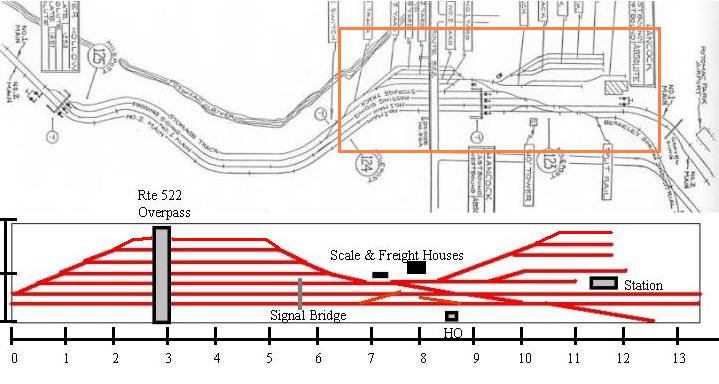I chose Hancock, WV for this example. Hancock is a small facility on the border of West Virginia and Maryland. It is west of Brunwick and east of Cumberland. It sits near the banks of the Potomac River and has a branch line (Berkley Springs Industrial Track) heading to the south. It is also the home of HO Tower, which was one of the last operating mechanical interlocking towers in the country.
If I simply made a perfect model of Hancock in HO (1/87 scale), it would be a model that was hundreds of feet long and tens of feet deep. I don't have that sort of room, so I need to compress the scene.
Below is a graphic showing what I did.

HOW TO:
1. Find a track plan for the area you want
to model.
I got my track plan from the B&O museum. This is
available on
line, see my links page for the link. The entire
collection of track
plans from Brunswick to Cumberland cost around $20.
2. Define the space you have to dedicate to the representation of Hancock. I had a space 2 feet deep and 13 and a half feet long. Also define the orientation. On my layout, north is always the back of the layout, making west to the left and east to the right. This is how most people think (North = Up).
3. You now have the prototype layout and the space available. Next, you need to understand the PURPOSE of the real Hancock. Hancock is a small yard that collects sand and pulpwood loads from the Berkley Springs Industrial Track. Without this branch line, there would be no Hancock. Therefore, the Berkley Spring Industrial Track is our most important element to model. I visited Hancock, to see first hand how the yard operated and to get the lay of the land. I took a video, so I could always reference the details as I build the scene.
4. Next, the yard is important. It is where all the empties are stored before going to Berkley Springs and all the loads are stored before they get picked up by a passing train. The yard is our second most important feature and must be maintained. All other features are secondary.
5. I outlined on the graphic in an orange box, what part of the real track plan is the "heart" of Hancock. It is the part I concentrated on modeling. The track leads to the left of the square are nice to have, but not required. What is required is a yard and a branch line.
6. I started with placing the main lines. I tried to avoid placing them perfectly parallel to the front of the layout, but several things made this necessary. First, the yard is all to the north of the main lines. This forces the main lines to be located near the front of the layout. Also, since there are yards on both the extreme left and right of the scene, I could not angle the main lines without losing substantial trackage in either yard.
7. With the main lines placed, I estimated where I needed the branch line to split off. I chose the 11 foot mark, which gives me a good approach into the Berkley Springs scene which sits in the bottom right corner of my Hancock scene.
8. After the main lines and the branch were placed, I added the cross overs on the main line. This will allow trains from either direction and either main line to set out and pick up cars in the yard. This is just what they can do at the real Hancock, and what I wanted to preserve in my model of Hancock.
9. Once the cross overs were in place, the yard tracks could be added. I started with the yard on the left. The space available allowed for a three track yard. This is just half of the tracks at the real Hancock, but it is not important to represent every track, just to have a yard like the real one to store cars. This yard will hold about 12 sand cars, which is adequate for my railroad.
10. With the yard on the left created, I focused on the yard on the right. From photos I saw lots of sand cars stored on these tracks too, so I didn't want to leave them off. I acually had room in this design for all but one of the tracks.
11. With all the tracks placed, I added the passenger station, HO tower, the freight and scale houses. Luckily, there ar just these four structures at Hancock, and all fit nicely. Scratch building the unique HO tower will make the scene instantly identifiable to those who know HO. Finally I placed the Route 522 overpass and signal bridge. My signal bridge only serves three tracks (4 on the prototype), but that 4th track isn't needed to preserve the feel of Hancock. The Route 522 overpass is a landmark and dominates Hancock yard, so I was happy to be able to fit it in.
12. With the compression complete, it is important to note what I didn't include. I didn't include the river as it is too far away for this scene. I didn't include the large hill south of Hancock as it is too far away for this scene. The road running next to HO tower also is not included for that reason. The road will pop up in the Berkley Springs scene as the branch line crosses it (just outside the orange rectangle above). The running and storage tracks are not included, as they are not really necessary for prototypical operations.
13. Now I have a track plan that is not nearly as long as the real thing, but still preserves the feel and the type of real operations at Hancock, WV. Try applying these steps to whatever area you are modeling.